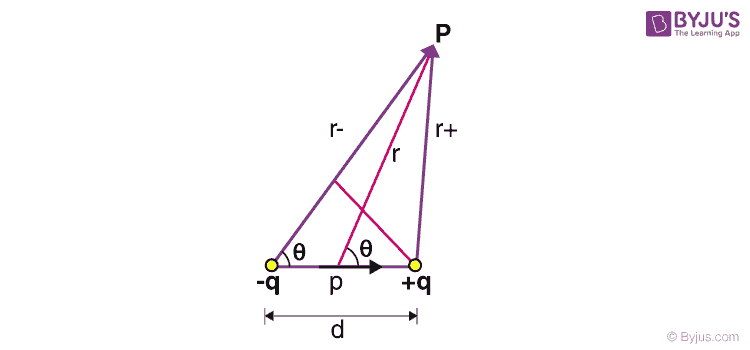Before we understand the characteristics of the electric potential of a dipole, let us quickly review our understanding of dipole and electric potential. An electric potential is the amount of work needed to move a unit positive charge from a reference point to a specific point inside an electric field without producing acceleration. A dipole is a pair of opposite charges with equal magnitudes separated by a distance, d.
The electric potential due to a point charge q at a distance of r from that charge is given by,
The electric potential is a scalar field whose gradient becomes the electrostatic vector field. Since it is a scalar field, it is easy to find the potential due to a system of charges. It is the summation of the electric potentials at a point due to individual charges.
Thus, we can write the net electric potential due to the individual potentials contributed by charges as
Let us use this concept to find the electric field of a dipole. Let the distance between the point P and the positive and negative charges be r+ and r– respectively. Let the distance from the midpoint of the dipole be r. Let this vector subtend an angle θ to the dipole axis. Thus using the above theorem, we have,

If the point P is sufficiently far from the dipole, then we can approximate
Thus, we can write the potential as:
We know that the magnitude of the electric dipole moment is:
Thus, electric potential due to a dipole at a point far away from the dipole is given by,
Notice that the potential falls off by r2 while the electric field falls off by r3. Also, note that when the angle is 90⁰, the point P is equidistant to both charges, and the electric potential is zero. When θ > 90⁰, the potential is negative because the point P is closer to the negative charge.
Recommended Video:
Important JEE questions on Electrostatic Potential and Capacitance

Know About Electric Field due to Dipole
 s
s
Frequently Asked Questions – FAQs
What is an electric charge?
What is electric potential?
What is the SI unit of the dipole moment?
What is an electric dipole?
What is the direction of an electric dipole moment?
Stay tuned with BYJU’S for more such interesting articles. Also, register to “BYJU’S – The Learning App” for loads of interactive, engaging Physics-related videos and unlimited academic assistance.

Comments